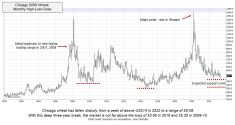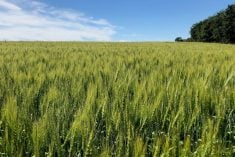Statistics Canada’s June acreage survey held no surprises. Corn, soybean and wheat acreage was similar to March data. There was some yield drag on corn and soybeans in the dryer regions of Ontario but crops have held up well. Basis levels remain firm due to tight old crop stocks and uncertain new crop production.
Quick look:
Soybeans: Demand for old crop Ontario soybeans is coming in below expectations.
Corn: Chinese corn import demand for the 2021-22 crop year is expected to come in around 26 million tonnes.
Wheat: Production has potential to reach 2.5 million tonnes, up from 2020.
As of June 27, the U.S. corn crop was rated 64 per cent good to excellent. This is down four per cent from the June 13 rating. The U.S. soybean crop was rated 60 per cent good to excellent. This compares to 62 per cent on June 13. Given the tighter ending stocks for the 2020-21 crop year, the corn and soybean markets cannot afford a crop problem.
Read Also

Scouting advised for soybean aphids
Soybean aphids have been spotted in a few fields in southern Ontario that haven’t seen soybean aphids in quite a…
Brazilian farmers have harvested approximately five per cent of Safrinha corn crop. Argentinian producers have combined 55 per cent or the corn crop and have basically finished the soybean harvest. The European, Ukraine and Russian winter wheat harvests will move into high gear during July. France and parts of Europe are experiencing adverse rains, which may downgrade quality.
On June 25, the U.S. Supreme Court ruled in favour of refiners regarding extensions on their exemptions to the Renewable Fuels Standard. Ethanol and biodiesel demand from U.S. refiners could be lower than expected in the upcoming crop year because of blending requirements.
Soybeans
According to StatsCan, Ontario farmers planted 2.936 million acres of soybeans this spring, up from the 2020 seeded area of 2.85 million acres. At this stage of the growing season, we feel comfortable using a five-year average yield of 47.5 bu./acre, which is down from the 2020 yield of 50.7 bu./acre. Ontario soybean production has potential to come in around 3.8 million tonnes, down from 3.9 million tonnes last year. The five-year average production is also 3.8 million tonnes.
Demand for old crop Ontario soybeans is coming in below expectations. Fresh export business has slowed considerably late in the crop year. Domestic processing has been running at a similar pace to last year. However, local crushers take their downtime for maintenance and upgrades during the summer. There is little reason to see additional strength in old crop soybean prices as demand fades.
New crop prices are being influenced by U.S. growing conditions. Soybean crops in North Dakota, South Dakota, Nebraska, Minnesota and Northwest Iowa have experienced yield drag due to dryer conditions. Despite the year-over-year increase in acreage, the U.S. soybean production will likely finish similar to year-ago levels.
Another factor driving new crop prices will be the export pace of South American origin soybeans. Brazil and Argentina are dominating the export market. The exportable surplus from these two producers will be absorbed by the time U.S. new crop supplies come available during October.
The U.S. will be the major world supplier from October through February 2022. Ontario soybean prices will experience seasonal strength over the winter period as domestic prices move in tandem with U.S. values.
What to do: We’ve advised producers to be 100 per cent sold on old crop soybeans and 20 per cent sold on new crop. If yields deteriorate further in Canada and the U.S. the market will incorporate more of a risk premium. July and August are critical for determining the price structure for the 2021-22 crop year.
Corn
Statistics Canada’s acreage survey had Ontario corn acres at 2.146 million, down 2.1 per cent from last year. The March survey had acreage up acreage up 1.7 per cent. Using a five-year average yield of 162.3 bu./acre, Ontario corn production has potential to reach 8.7 million tonnes, down from 2020 output of 8.9 million tonnes.
The corn market is in a unique situation. We have to look at history to determine the marketing strategy for the 2021-22 crop year. During the 2011 and 2012 crop years, U.S. corn fundamentals were similar to 2020-21. In 2011, the corn market made a high in first two weeks of June; the highs of 2012-13 occurred during the first week of August 2012.
When U.S. corn ending stocks are tight and the upcoming crop is uncertain, the highs are made during the summer. This is contrary to the soybean market, which tends to make highs as demand grows over winter. This appears to be the pattern for corn when U.S. ending stocks are sharply below the five-year average.
Ontario and U.S. domestic feed demand makes a seasonal low from July through September. This is when cattle on feed numbers are at the lows of the year. In addition to softer demand, the substitution effect is limiting the upside for corn prices.
Wheat is moving into feed channels In Ontario, Western Canada, Europe, Southeast Asia, China and the U.S. Southern Plains. On the export side, Brazilian and Argentine corn is a sharp discount to U.S. corn out of the Gulf and Ontario corn out of the St Lawrence. There is no fresh export business for old crop corn. U.S. basis levels have softened in the Gulf and collapsed in the interior.
Chinese corn import demand for the 2021-22 crop year is expected to come in around 26 million tonnes, similar to 2020-21. The only difference is that South America origin will make up a larger portion of these imports.
Without going into detail, the U.S. will experience a year-over-year increase in production. Domestic feed usage will be down from last year due to increased wheat feeding in the first half of the year. Ethanol usage will be similar to year-ago levels.
What to do: We’ve advised producers to be 100 per cent sold on old crop and 20 per cent sold on new crop. Similar to the soybean market, our strategy for the 2021-22 crop year will be determined by yield development in the U.S. and Ontario over the next two months. If ending stocks are sharply below the five-year average for the second year in a row, we can be patient on additional sales.
Wheat
Ontario winter wheat remaining after the winter came in at 1.082 million acres, up from 1.037 million acres last year. Using a five-year average yield of 83.6 bu./acre, production has potential to reach 2.5 million tonnes, up from the 2020 winter wheat production of 2.3 million tonnes.
Ontario spring wheat acres were estimated at 96,800, down about 20,000 acres from last year. We’re forecasting Ontario spring wheat production to reach 134,400 tonnes, down from the 2020 spring wheat crop of 146,900 tonnes.
The winter wheat market is moving through seasonal lows. There is potential for delays due to rains in France and parts of Germany; however, this won’t have much effect on the overall wheat complex. Feed is the main factor supporting wheat.
In the U.S. Southern Plains, hard red winter wheat has been trading into feedlot rations since early spring. This will continue until corn supplies are available in October. Despite the year-over-year increase in production, the U.S. hard red winter wheat ending stocks for the 2021-22 crop year will again be sharply below the five-year average.
A similar situation is developing in Europe, which is the largest user of wheat in compound feed rations. We’re looking for an increase in production but the year-over-year increase in feed demand will absorb the excess.
Western Canada and the U.S. Northern Plains are experiencing drought-like conditions. North American hard red spring fundamentals are expected to be tight in the 2021-22 crop year. This will underpin milling wheat prices in North America.
We don’t typically see a substitution effect for hard red spring wheat so the North American hard red milling market trades at a premium to world values to curb exports. A large portion of hard red spring wheat demand is inelastic, which can make the market quite volatile.
What to do: We’ve advised producers to be 100 per cent sold on old crop and 20 per cent sold on new crop. Russia and the Ukraine will dominate the export market in the first half of the crop year. We’re looking for the wheat market to make seasonal highs in October, just before the main Northern Hemisphere corn harvest.















